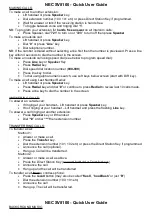
148
Glossary
Gigaset S675 IP / ALGERIAN eng / A31008-M1915-A751-1-3T19 / glossary.fm / 27.10.08
Ve
rsion 4, 16.09.2005
to use (alternatively)
in the router,
in the VoIP telephone, or for the
VoIP provider to use an
If an outbound proxy is made available
you must allow for this in the VoIP set-
tings for your phone.
Network
Group of devices. Devices can be con-
nected in either wired or wireless
mode.
Networks can also differ in range and
structure:
– Range: local networks (
) or
wide-area networks (
– Structure:
or ad-hoc network
Network subscribers
Devices and computers that are con-
nected to each other in a network, e.g.
servers, PCs and phones.
O
Outbound proxy
Alternative NAT control mechanism to
STUN and ALG.
Outbound proxies are implemented by
the VoIP provider in firewall/NAT envi-
. They control data traffic
through the firewall.
Outbound proxy and STUN servers
should not be used simultaneously.
See also:
P
Paging
(handset search)
A base station function to locate regis-
tered handsets. The base station estab-
lishes a connection to every registered
handset. The handsets start to ring.
Paging is activated by briefly pressing
the button on the base station and is
deactivated by briefly pressing the
same button again.
PIN
Personal Identification Number
Protects against unauthorised use.
When the PIN is activated a number
combination has to be entered in order
to access a protected area.
You can protect your base station con-
figuration data with a system PIN (4-
digit number combination).
Port
Data is exchanged between two appli-
cations in a
via a port.
Port forwarding
The Internet gateway (e.g. your router)
forwards data packets from the
that are directed to a certain
to
the port concerned. This allows servers
in the
to offer services on the
Internet without you needing a public
IP address.
Port number
Indicates a specific application of
. Depending on the
setting in the
, the port number is
permanently assigned or else it is
newly assigned with each access.
The combination of
/
number uniquely identifies the recipi-
ent or sender of a data packet within a
network.
Pre-dialling
See
Private IP address
See
.
Protocol
Describes the agreements for commu-
nicating within a
. It contains
rules for opening, administering and
closing a connection, about data for-
mats, time frames and possible error
handling.
















































